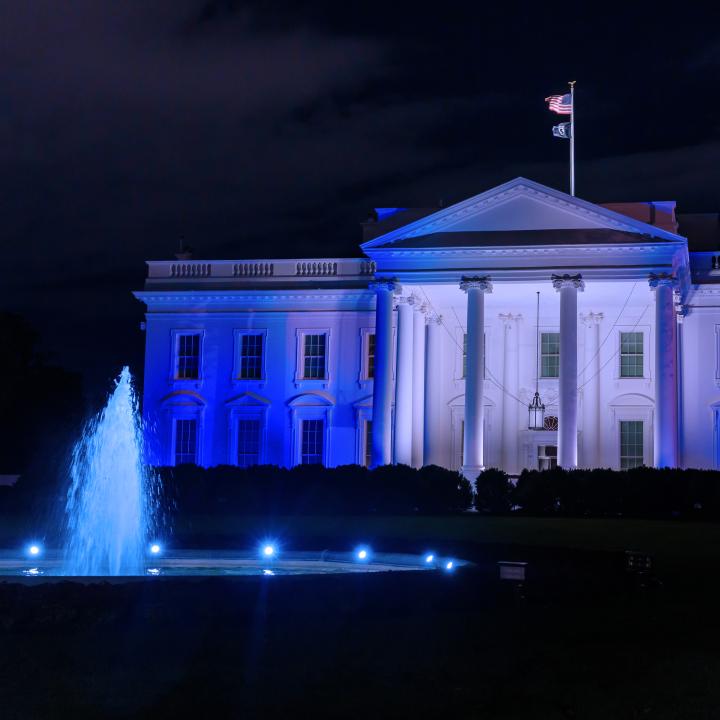
- Policy Analysis
- PolicyWatch 4113
U.S.-Israeli Reflections on the Anniversary of October 7, 2023

Distinguished former officials and analysts mark two years since the horrific attack on Israel, assessing how best to build on new diplomatic momentum in Gaza while avoiding long-term damage to the prospects of regional integration.
Robert Satloff
The good news is that Israel has won virtually all the key battles of the multifront conflict that followed Hamas’s surprise attack on October 7, 2023. This dramatically shrank the threat to Israeli security posed by radical Islamist enemies who remain committed to destroying the Jewish state. But given that war is, as Clausewitz explained, “politics by other means,” there is bad news, too—success in all those battles does not mean Israel has yet emerged as the victor. After all, “Israel as Sparta” was never the Zionist dream. Despite suffering repeated defeats, Iran’s threat network and other adversaries have made great strides toward turning Israel into an isolated island in a sea of animosity, with help from fellow travelers in chancelleries, newsrooms, and campuses across America and around the world. And Israel has done itself no favors by failing to translate battlefield success into political achievements.
Hopefully, President Trump’s new Gaza peace plan provides a way out. If implemented, it offers a different future for Israelis and Palestinians and a pathway back to integrating Israel into the region. But even if the plan is stillborn, Israel has turned the tables on its critics by embracing an internationally recognized formula for peace. Although that alone may not be enough to quiet the detractors, it may give Jerusalem a chance to chip away at the wall of isolation. Shoring up support among erstwhile friends and partners is especially important to Israel given the need for continued vigilance in addressing unfinished business with antagonists—in Iran, Lebanon, Yemen, and elsewhere—who are battered but unbowed.
Michael Herzog
Two years after the brutal attack, Israel’s strategic landscape offers a bifocal view. Through one lens, the country has risen from the worst blow in its history to turn the tables on Iran’s regional axis and significantly set back the regime’s dangerous nuclear and missile programs. This shuffling of the deck has opened new opportunities for nonbelligerency arrangements with Syria and Lebanon as well as normalization with Saudi Arabia, all under a “Pax Americana” umbrella.
Through another lens, however, Israel’s amazing achievements are overshadowed by its failure to realize its war goals in Gaza—a most challenging military, humanitarian, and political environment—and bring the fighting there to a successful close. Hamas has been militarily defeated but still holds power, arms, and forty-eight hostages, twenty of whom are believed to be alive. This view of a drawn-out war with no clear endgame and heavy human and material tolls has cost Israel an exceedingly high price: a painful strain on a society deeply divided over the war’s priorities and direction, and an unprecedented loss of global prestige and standing amid a vicious international campaign targeting the country’s very legitimacy. Israel views the post-October 7 conflict in existential terms and sees itself as spearheading a clash of civilizations in the interest of the West. Yet most of the world increasingly views the fighting through the lens of the unresolved Israeli-Palestinian conflict, to the point of putting most of the blame on Jerusalem’s shoulders.
At the same time, the war has underscored the importance of Israel’s strategic alliance with America—indeed, only the U.S. administration can bridge the above gaps. Yet this will require a “unifocal” effort that reconciles Israel’s growing sense of vulnerability with a viable political path toward ending the war and exploring new regional horizons. One hopes that the Trump administration knows how to handle this big challenge.
Dennis Ross
Few would have anticipated that two years after the Hamas onslaught, war would still be raging in Gaza. Fewer still would have predicted Israel’s devastation of Hezbollah, the fall of Bashar al-Assad’s regime in Syria, and the dramatic setbacks to Iran’s nuclear program. Israel not only succeeded in changing the balance of power in the region, but by destroying much of Iran’s air defense network and nuclear infrastructure, it also facilitated the Trump administration’s decision to launch devastating strikes against Fordow, Natanz, and Isfahan. With these factors taken together, the Iranians now know they no longer have impunity from attack. Prior to this year, Iranian leaders believed they were safe from direct military strikes on their soil because their threats to convulse the region had deterred successive American presidents. With that confidence gone, their proxy network weakened, and potentially meaningful change afoot in Lebanon and Syria, the region could be headed in a much more promising direction—and away from Tehran’s hegemonic ambitions.
Yet as is always the case in the Middle East, the promise of progress requires a strategy to turn the latest military successes into durable political outcomes. Lacking an endgame for Gaza, Israel’s current government never developed such a strategy, even though doing so could have enabled a regional transformation that included full Israeli integration. Such integration seemed imminent on October 6, 2023, but now seems clearly more distant. Can the Trump peace plan change that?
Some argue that Arab leaders have lost their appetite for normalization with Israel given its continued campaign in Gaza and other military operations throughout the region. True, their societies have grown more hostile toward Israel, raising the costs of diplomatic outreach to Jerusalem for them. But it is far too early to be drawing sweeping conclusions about Israel’s long-term place in the region, since so much depends on what happens in Gaza.
Consider, for example, that if the Trump plan is implemented, it will require close coordination between Israel and those Arab governments who play a role in Gaza’s transitional governance. That would give states like Saudi Arabia a major stake in working with Israel, in addition to creating a potentially important first step in a new political process between Israelis and Palestinians. Moreover, with elections looming next year, there is also the prospect that a new (or even modified) Israeli government will feel the need to act in ways that help restore its image and standing in the region and internationally. These and other factors may wind up reviving the pre-October 7 push for regional integration—though this time around, the push might begin with economic infrastructure projects like the India-Middle East-Europe Economic Corridor (IMEC) rather than jumping straight to political normalization.
Dana Stroul
The U.S.-Israel military relationship has reached unprecedented levels since the October 7 attack, building on several years of deep enhancements following the signing of the Abraham Accords and Israel’s incorporation into U.S. Central Command’s area of responsibility. Israel had already cultivated the most professional, adept military in the Middle East over the decades, with steady bipartisan support from Washington and successive memorandums of understanding regarding U.S. security guarantees and missile defense funding. In the two years after October 7, it applied these unmatched capabilities to set back Iran’s nuclear program, missile arsenal, and regional network of terrorist groups. At the same time, Washington employed American military capabilities in unprecedented ways to support Israel, providing arms from its own stocks, diverting aircraft carriers and other capabilities to the Middle East—including two Terminal High-Altitude Area Defense (THAAD) missile defense systems inside Israeli territory—and increasing the pace of U.S. strikes in Iraq, Syria, and Yemen to prevent further Iran-backed aggression.
Taken together, these efforts have profoundly changed the region’s strategic landscape, opening a path for Israel to work with its Arab neighbors on long-term security in ways that were not available before October 7. Two key features define this new landscape. The first is a shift from clashes with Iran’s terrorist network abroad to direct warfare, including state-on-state attacks in April 2024, October 2024, and June 2025. Notably, all of these attacks occurred without drawing in other regional states, while the United States itself joined the fighting in June after Israel cleared airspace for American forces to strike Iran’s nuclear facilities.
Second, post-October 7 defensive operations have involved multinational coalitions: in April 2024, an unprecedented U.S.-coordinated coalition largely defeated a large-scale Iranian missile and drone attack; in October 2024, the United States actively participated in Israel’s defense against an Iranian ballistic missile attack. These developments indicate an evolution in Israel’s longstanding security doctrine of “defending itself by itself,” as well as a new era for direct U.S.-Israel military operations in the Middle East.
Despite these achievements, however, Israel has missed two windows to transition from high-intensity combat operations to political processes: early this year following U.S.-facilitated ceasefires in Lebanon and Gaza and the collapse of the Assad regime, and again this summer following the twelve-day war with Iran. In both cases, Israeli leaders declined to invest sufficiently in negotiations and multilateral diplomacy that could have ended the fighting in Gaza, freed the hostages, and defined a vision for post-Hamas governance in the Strip. These missed opportunities have eroded regional support for Israel and undermined U.S. efforts to facilitate security arrangements and normalization agreements with Arab and Muslim governments, including accelerated military integration. The question now is how much Washington will press Israel to take advantage of a third window—the one opened by President Trump’s proposed twenty-point plan that aims to end military operations in Gaza and bring in Israel’s neighbors as stakeholders for a non-Hamas future there.
Neomi Neumann and Ghaith al-Omari
The conflict that began on October 7 has become the longest and costliest in Israel’s history and the most devastating for Palestinians, with deep regional and international consequences as well. Prior to the rush of new diplomatic activity over the past week, the war was showing little sign of resolution as it approached its third year. Both Israel and Hamas had rejected mediation efforts despite mounting losses, seemingly preferring military confrontation without offering clear political alternatives or translating battlefield gains into progress at the negotiating table.
Unless the latest proposal bears fruit, Israel’s “total victory” risks becoming Pyrrhic, while the pride that many Palestinians felt after the October 7 attack is more likely to be remembered as another nakba (catastrophe). Israel faces growing diplomatic isolation and economic pressure, prompting Prime Minister Binyamin Netanyahu to acknowledge the need for a more self-reliant economy. On the other side, Hamas has lost most of its leadership, infrastructure, and operational capacity, shifting from a governing authority to a guerrilla movement fighting for survival. Meanwhile, the people of Gaza have suffered widespread human losses, immense destruction, repeated displacement, and threats of permanent expulsion.
Conditions in the West Bank have deteriorated sharply as well. Israel has adopted a zero-tolerance approach to Palestinian violence, leading to heightened military operations inside the territory. The Palestinian Authority continues to weaken and lose legitimacy, with help from certain Israeli ministers who seek its collapse. These same ministers are also pushing policies to reshape the West Bank’s demographic and physical landscape in ways that threaten to block future Palestinian statehood.
The recent international campaign to recognize a Palestinian state—including by countries in Europe—highlights the gap between global declarations and realities on the ground. Disillusioned by past failures, the Palestinian public remains skeptical, while the majority of Israelis now see no path to a two-state solution. Ironically, the harder the outside world pushes for statehood, the more distant its realization appears.
The current U.S.-backed proposal offers a potential framework for ending the impasse over Gaza, though both sides face hurdles: Hamas will need to disarm without solid guarantees that its remaining leaders will be safe, while Israel must reconcile its rejection of PA involvement in Gaza and future statehood with Arab demands that both of these elements be included in some form as preconditions for their joining the initiative. At the same time, the proposal gives all stakeholders an achievement they can point to and build on. If it manages to bridge gaps, the plan may offer the first viable path toward de-escalation and the beginning of a broader regional realignment.







